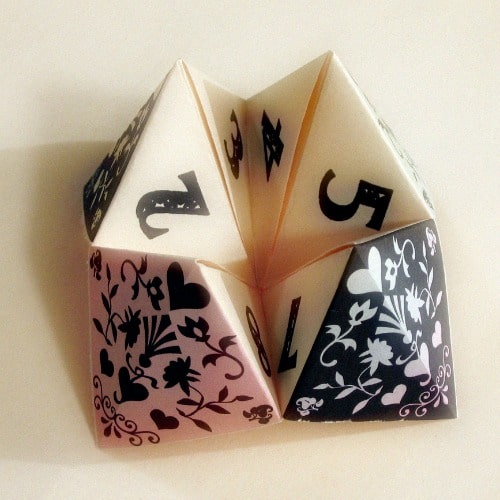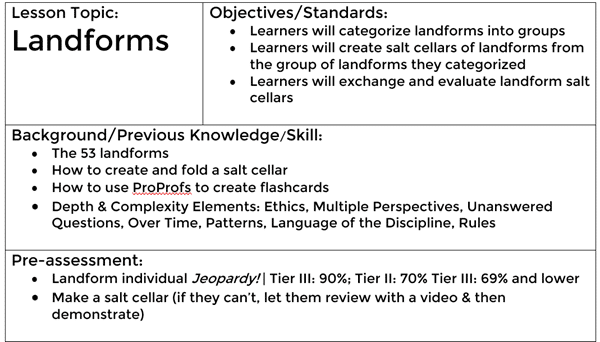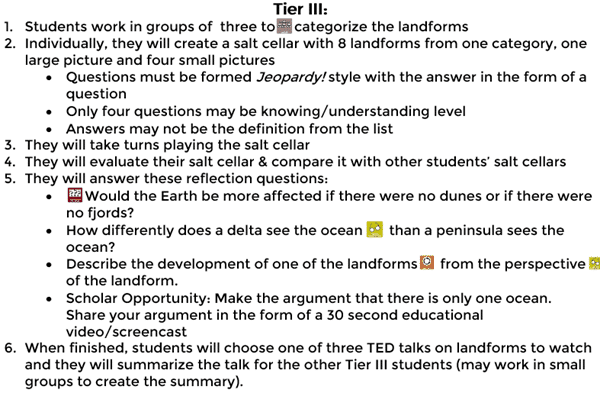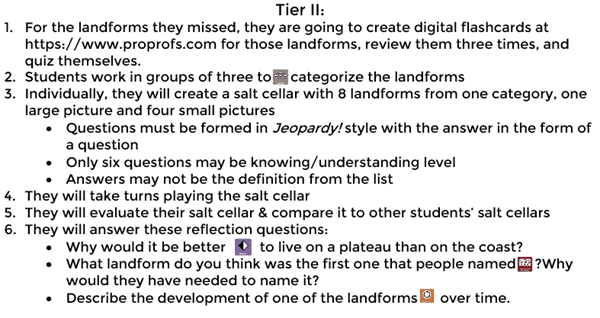
I’m going to share a differentiated lesson plan from start to finish. In the article Begin with the Highest Level Learner in Mind I promised that I would share the process, and here it is.
I decided to do a 5th grade lesson on landforms. To be more specific, I decided to create a summative activity for the end of a unit on landforms. While most people choose some kind of test, I like to have the end-of-unit activities be a little more varied.
If you don’t teach landforms, no worries. It’s the process we’re looking at here, and that is not content-dependent.
In this activity, students will create a salt cellar to apply their understanding about landforms. A salt cellar is another name for a cootie catcher (sometimes called “fortune tellers”).

I find the term “cootie catcher” awkward in classroom use, so I use the term that was first used to describe them in English, which is salt cellar. A salt cellar is something that holds salt, and if you turn them upside down, that’s what they look like.
I hope that by looking at this, you’ll come away with four things:
If you teach landforms, you also get a great lesson plan!
First, I need my objectives. I have to do that whether I differentiate or not.
I also need to list out what background/previous knowledge/already mastered skills the students need to have and what pre-assessment I will use.
I would do all of this whether I were differentiating or not. This will change as I work on the lesson plan, but I start with what I know and add to it as I develop the plan.
You may say, “No, you wouldn’t preassess,” but I think it’s best practice to preassess all learners, so, yes, I would.

When I begin the actual lesson plan, I start with my highest level learner in mind. For this lesson plan, I’m using the Depth & Complexity framework because that’s what I do. If you don’t use Depth & Complexity (Why not. ), you can just leave that out.

Once I’ve got what I’m doing for my highest level learners in mind, I literally copy and paste it and then adjust it for my on-level learners, as I wrote about in Begin with the Highest Level Learner in Mind.

Next, I copy and paste this and adjust for my learners who need more support.

If you take a moment to compare the levels, you will notice the types of changes I made. It’s particularly important to see that they’re not necessarily doing much different. It’s the thinking that changes.
After I create this part, I look at the plan and list what components I need to create. In this lesson, I needed:
They are all included in the lesson plan you can download.
As I began to work on the lesson plan, I realized it might be helpful to actually show you what it looks like for me as I prepare a lesson beginning with the highest level learner in mind. I recorded a screencast of the process as I start it.
After making the recording, I worked on it more (you probably wouldn’t find a video of the entire experience interesting!), making it a full and complete experience.
You can get the entire Landforms Salt Cellar Lesson Plan if you would like to use it or even just see what a full differentiated lesson plan looks like.
It has the rubrics and the templates and lots of other goodness. I’ve uploaded it as a pdf to retain formatting.
As I was working on it, I kept track of how much extra time it took because I differentiated for gifted learners. I believe I had a net savings of 43 minutes of time.
Here’s how that broke down:
If I planned it well, I could have had my high-ability students create the Jeopardy! too, which would have saved even more time.
Even if you take out the time savings, the time extended was only 17 minutes. Divided by the number of high-ability kids in the class, what is the time cost per child? Please look me in the eye and tell me they’re not worth it.
That doesn’t even count the time savings involved in having appropriate lessons for students that I mentioned in the article
Begin with the Highest Level Learner in Mind.
I hope that this glimpse backstage to the process will help clear up misunderstandings about the time and effort involved in differentiating instruction.

